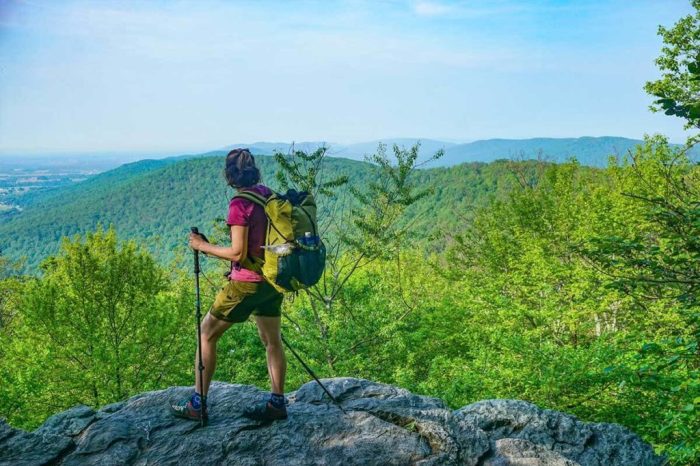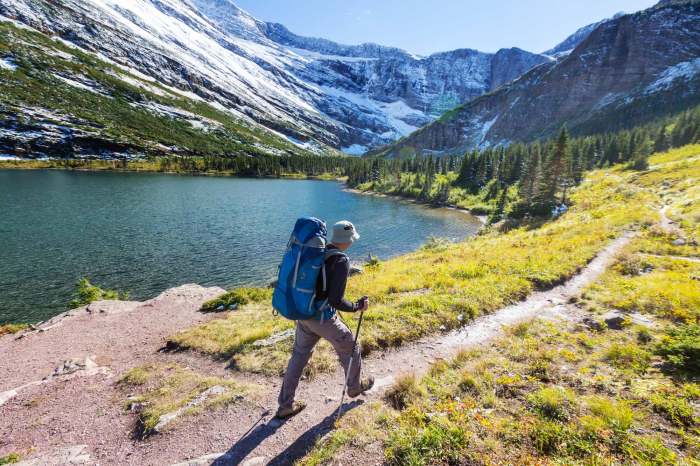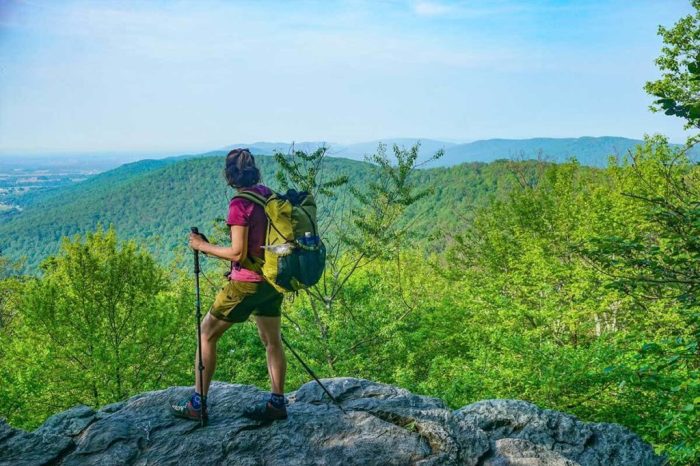Best treks in the world—a journey through breathtaking landscapes, cultural immersion, and unforgettable experiences. From soaring mountain peaks to sun-drenched deserts and lush jungles, this exploration delves into the heart of incredible trekking adventures around the globe. Prepare to be captivated by the diverse tapestry of the world’s finest treks, each offering unique challenges and rewards.
This guide will take you on a comprehensive exploration of the world’s most remarkable trekking destinations. We’ll delve into the criteria for selecting the best treks, exploring factors such as difficulty, scenery, cultural significance, and safety. Expect a detailed look at geographical regions, trekking difficulty and duration, essential gear, and safety precautions. Get ready to discover the hidden gems and unforgettable experiences that await.
Introduction to Treks
Trekking, at its core, is a form of extended walking, typically in mountainous or challenging terrain. It involves traversing a marked route, often with overnight stays in designated campsites or lodges. This activity goes beyond mere walking; it embodies exploration, physical endurance, and cultural immersion. It’s a profound way to connect with nature and gain personal insights.The history of trekking is intertwined with the development of exploration and travel.
Early forms of trekking involved indigenous communities navigating their territories, later evolving into organized expeditions and tourism. Over time, trekking has become a popular activity, attracting adventurers and nature lovers alike. It has also become a crucial element of cultural exchange and preservation, as trekking often takes place in areas rich in historical and cultural significance.
Types of Treks
Treks vary significantly based on the environment and their purpose. Different types cater to varying levels of experience and preferences. Understanding the diverse range of trekking options is essential for selecting a suitable adventure.
Mountain Treks
Mountain treks are characterized by their elevation gain and the rugged terrain. These treks often involve challenging ascents and descents, requiring participants to be physically fit. Famous examples include the Inca Trail to Machu Picchu in the Andes Mountains and the Annapurna Circuit in the Himalayas. These treks are not only physically demanding but also provide stunning views and opportunities to observe diverse ecosystems.
Desert Treks
Desert treks, on the other hand, offer a unique challenge, highlighting the resilience of humans and their adaptability to extreme environments. These treks are characterized by their vastness and the need for meticulous planning to navigate the scorching sun, sandstorms, and water scarcity. They may include camel trekking, hiking, or a combination of both. Examples include the Sahara Desert and the Namib Desert treks.
Speaking of incredible hikes, some of the best treks in the world are truly breathtaking. From the towering peaks of the Himalayas to the lush jungles of Southeast Asia, the world offers countless amazing trails. However, if you’re looking for a stunning destination that combines natural beauty with cultural experiences, you absolutely have to consider Taiwan. Exploring the diverse landscapes of Taiwan, from the dramatic mountains to the charming villages, offers a unique hiking experience that’s hard to beat.
The best places to visit in Taiwan offer so much more than just beautiful treks. best places to visit in taiwan will give you a great starting point for planning your adventure. Ultimately, the best treks in the world often involve more than just the physical journey, but the exploration of a culture and a place.
Jungle Treks
Jungle treks present a different set of challenges, requiring a deeper understanding of the environment and the ability to navigate dense vegetation. The terrain is often uneven, and the climate can be humid and unpredictable. Participants may encounter various wildlife and experience a unique ecosystem. These treks are often popular for wildlife viewing and cultural immersion, such as the treks in the Amazon Rainforest.
Comparison of Trek Types
| Trek Type | Terrain | Climate | Typical Activities |
|---|---|---|---|
| Mountain | Rugged, mountainous, varying elevation | Variable, depending on altitude and season | Hiking, rock climbing (in some cases), wildlife spotting |
| Desert | Vast, sandy, often uneven | Extreme temperatures, arid | Hiking, camel trekking, camping, navigating by compass and map |
| Jungle | Dense vegetation, rivers, streams | Hot, humid, unpredictable | Hiking, navigating trails, wildlife viewing, cultural immersion |
Criteria for “Best” Treks

Defining the “best” trek is inherently subjective, influenced by individual preferences and priorities. However, certain factors consistently emerge as key determinants, shaping a trek’s overall appeal. These criteria go beyond mere physical exertion, encompassing cultural immersion, environmental appreciation, and personal safety. Ultimately, the “best” trek resonates with the trekker’s values and aspirations.Trekking experiences are significantly shaped by a multitude of intertwined elements, from the breathtaking vistas to the local communities encountered along the way.
Choosing a trek that aligns with one’s personal preferences and understanding of the conditions is crucial for a positive and memorable experience. This includes assessing the trek’s difficulty, the scenic beauty, and the cultural richness it offers, as well as the crucial aspect of safety precautions.
Factors Determining Trek Quality
A high-quality trekking experience hinges on a careful balance of factors. Difficulty levels, scenic beauty, and cultural immersion all play a significant role in determining the overall quality of a trek. These factors are often intertwined and contribute to the overall experience.
- Difficulty: The physical demands of a trek are paramount. A trek that matches a trekker’s fitness level enhances enjoyment and minimizes the risk of injury. Overly challenging treks can lead to exhaustion, discomfort, and even accidents, diminishing the overall experience. Conversely, treks that are too easy might lack the necessary challenge and sense of accomplishment.
A well-matched difficulty level optimizes the experience, making it both rewarding and manageable.
- Scenery: The visual appeal of a trek is a crucial aspect. Breathtaking landscapes, unique flora and fauna, and awe-inspiring vistas are essential components of a memorable trekking experience. Trekking through pristine wilderness areas, encountering vibrant ecosystems, or ascending to high-altitude mountain passes contribute to a trek’s appeal and create lasting memories.
- Cultural Experiences: Interacting with local communities is often a highlight of a trek. Learning about local traditions, customs, and lifestyles provides a deeper understanding of the region and its people. Respectful interactions with locals, opportunities to learn about their culture, and engagement in their daily lives enrich the trekking experience. These interactions foster cultural understanding and appreciation, creating a more meaningful connection with the destination.
Safety Considerations
Prioritizing safety is paramount when selecting a trek. Accidents can occur in any trekking environment, highlighting the need for careful planning and preparedness. Thorough research, appropriate gear, and a comprehensive understanding of the trek’s challenges are essential.
- Trail Conditions: Assessing the trail’s condition, including elevation changes, terrain, and weather patterns, is crucial. Understanding the potential challenges of the route ensures the trek aligns with one’s capabilities and minimizes risks.
- Local Regulations: Familiarizing oneself with local regulations, including permits, permits and trekking guidelines, is essential. Compliance with local rules ensures a respectful and compliant trekking experience.
- Emergency Preparedness: A comprehensive plan for emergencies, including communication options, emergency contacts, and emergency supplies, is vital. Preparation minimizes potential risks and ensures safety during the trek.
Local Communities and Their Impact
Local communities are integral to the trekking experience. Their presence and involvement contribute to the cultural richness and authenticity of the trek.
- Community Involvement: The involvement of local communities ensures that the benefits of trekking are shared equitably. Support for local businesses, participation in local initiatives, and employment opportunities for locals enhance the positive impact of trekking.
- Cultural Preservation: Treks often contribute to the preservation of local cultures and traditions. Responsible tourism practices that respect local customs and values help maintain cultural heritage.
- Economic Benefits: Sustainable trekking practices create economic opportunities for local communities. Fair pricing, fair trade, and responsible employment contribute to the economic development of the region.
Environmental Impact and Sustainability
Environmental sustainability is paramount in the selection of the “best” treks. Minimizing the negative impact of trekking on fragile ecosystems is essential.
| Factor | Importance | Example |
|---|---|---|
| Waste Management | Proper waste disposal minimizes pollution and protects the environment. | Trekkers should carry out all waste, avoiding littering or leaving behind any garbage. |
| Water Conservation | Conserving water resources is essential in many trekking destinations. | Using water filters and minimizing water consumption, conserving water resources, and ensuring sustainable water sources. |
| Respect for Wildlife | Avoiding disturbing wildlife is vital for maintaining biodiversity. | Maintaining a safe distance from wildlife and avoiding any actions that could endanger their habitat or well-being. |
| Minimizing Footprint | Protecting fragile ecosystems requires minimizing disturbance. | Following marked trails and avoiding off-trail activities, respecting the natural environment, and reducing one’s impact on the ecosystem. |
Geographical Regions and Treks
Trekking offers a unique opportunity to immerse oneself in breathtaking landscapes and cultures. From the towering Himalayas to the lush Andes, the world boasts a plethora of exceptional trekking experiences. Understanding the geographical regions best suited for trekking is crucial for planning a memorable adventure. Different regions offer distinct challenges and rewards, catering to various skill levels and preferences.This exploration dives into the heart of these regions, highlighting the specific treks within each and their unique characteristics.
The diversity of terrains, from alpine meadows to dense rainforests, and the varied cultural encounters make trekking a truly rewarding experience. The following sections detail the top geographical areas for trekking, the notable treks within them, and a global perspective on the best destinations.
Top Geographical Regions for Trekking
The world’s trekking hotspots are diverse, offering varying levels of difficulty and breathtaking scenery. From the high-altitude peaks of the Himalayas to the cloud forests of the Andes, each region possesses its own unique charm. The choice of region depends on the trekker’s experience level, desired level of challenge, and the type of landscape they seek to explore.
Specific Treks within Each Region
Numerous trails within these regions cater to different preferences. The Inca Trail in the Andes, for example, is a challenging yet rewarding trek through ancient Inca ruins. In the Himalayas, the Annapurna Circuit is a popular choice for seasoned hikers, offering panoramic views of the mountains and surrounding villages. The unique characteristics of each trek, such as altitude, terrain, and cultural immersion, contribute to the overall experience.
Top 10 Trekking Destinations Globally
This list provides a glimpse into the best trekking destinations globally, emphasizing their unique appeal.
- Everest Base Camp Trek (Nepal): This iconic trek offers stunning views of Mount Everest and other Himalayan giants, a must for experienced trekkers.
- Inca Trail (Peru): Explore ancient Inca ruins and breathtaking Andean landscapes on this challenging but rewarding trek.
- Annapurna Circuit (Nepal): This circuit trail winds through stunning Himalayan landscapes, offering diverse trekking options for all experience levels.
- Torres del Paine Circuit (Chile): Experience the dramatic beauty of Patagonia’s granite peaks and glaciers on this challenging but rewarding trek.
- The Great Wall of China (China): Explore a section of the Great Wall on a trek through the mountainous regions of China.
- Mount Kilimanjaro (Tanzania): Ascend the highest peak in Africa, traversing diverse landscapes from rainforest to alpine tundra.
- Pamir Highway (Kyrgyzstan, Tajikistan): Explore the stunning landscapes of the Pamir Mountains on this adventurous trek, offering a glimpse into remote mountain cultures.
- Trekking in the Dolomites (Italy): Experience the beauty of the Italian Alps on a trek through the dramatic and picturesque Dolomites.
- The Haute Route (Switzerland, France): Traverse the majestic Alps on this classic alpine trek, crossing the border between Switzerland and France.
- Trekking in the Dolomites (Italy): Experience the beauty of the Italian Alps on a trek through the dramatic and picturesque Dolomites.
Comparison of Trekking Experiences in Different Continents
Trekking experiences vary significantly across continents. The Himalayas offer high-altitude challenges and stunning views of towering peaks, while the Andes present a unique blend of ancient ruins and dramatic landscapes. Patagonia’s dramatic granite peaks and glaciers offer a different perspective, showcasing the raw power of nature. The diversity of landscapes, cultures, and challenges creates a rich tapestry of trekking experiences worldwide.
Global Trekking Destinations Table
This table showcases the top treks and their locations on a global map.
| Trek Name | Country | Continent | Key Features |
|---|---|---|---|
| Everest Base Camp | Nepal | Asia | High-altitude trek with stunning Everest views |
| Inca Trail | Peru | South America | Ancient Inca ruins and Andean landscapes |
| Annapurna Circuit | Nepal | Asia | Diverse landscapes, varied trekking options |
| Torres del Paine | Chile | South America | Dramatic granite peaks and glaciers |
| Great Wall Section | China | Asia | Historic trek along the Great Wall |
Trekking Difficulty and Duration
Choosing the right trek involves understanding its difficulty and duration. A well-planned trek is crucial for a safe and enjoyable experience. Different treks cater to various levels of experience and physical fitness, from leisurely day hikes to challenging multi-day expeditions. This section delves into the grading of trek difficulty, the duration of treks, and the preparation needed for each type.Understanding the grading of treks is essential for matching the adventure to your abilities.
Different treks require varying levels of physical fitness and experience, and this section will Artikel the different levels to help you choose the right one. Duration also plays a key role, with shorter day hikes providing a taste of the mountains to longer multi-day expeditions that offer a more immersive experience.
Exploring the best treks in the world is incredible, but it’s also about savoring the journey. Fueling up with delicious local cuisine is key, and Ticino offers a fantastic slow food scene. For a deeper dive into where to find the tastiest treats and what to try, check out this fantastic guide on slow food in Ticino where to eat and what to try.
Ultimately, though, the best treks are those that let you truly appreciate the local flavors and experiences.
Trek Difficulty Levels
Trekking difficulty is graded based on factors such as elevation gain, terrain, and required navigational skills. These factors influence the physical demands of the trek, and a thorough understanding of these levels is critical for selecting a trek that aligns with your abilities. Common difficulty levels include beginner, intermediate, and advanced.
- Beginner Treks: These treks are generally suitable for individuals with little to no previous trekking experience. They often involve gentle slopes, well-maintained trails, and minimal elevation gain. A good example of a beginner trek might be a scenic loop around a lake with minimal elevation change.
- Intermediate Treks: These treks offer a step up in challenge compared to beginner treks. They may include some steep sections, uneven terrain, and moderate elevation gain. A good example of an intermediate trek might be a multi-day trek through a valley with a few challenging ascents.
- Advanced Treks: These treks are designed for experienced trekkers with a high level of physical fitness and mountaineering skills. They often involve significant elevation gain, challenging terrain, and potentially hazardous conditions. A good example of an advanced trek might be a high-altitude trek in the Himalayas with demanding ascents and exposure to extreme weather.
Trek Duration
The duration of a trek varies significantly, from short day hikes to multi-day expeditions. The duration directly impacts the physical and logistical demands of the trek. The time spent on the trail is a crucial factor to consider.
- Day Hikes: These treks typically last a single day, allowing for a taste of the outdoors. They are ideal for those who want a shorter adventure without committing to multiple days of trekking.
- Multi-Day Treks: These treks extend over several days or weeks, offering a more immersive experience of the mountain environment. They require careful planning, sufficient provisions, and the ability to sustain oneself for multiple days on the trail.
Physical Fitness and Preparation
Physical fitness is paramount for successful trekking, regardless of the trek’s difficulty or duration. Adequate preparation is crucial for both your safety and enjoyment. Proper training is essential for building the necessary endurance and strength.
- Physical Training: Building stamina and strength through exercises like hiking, running, and strength training is essential for any trek. The type and duration of training should be tailored to the specific demands of the chosen trek.
- Acclimatization: For high-altitude treks, acclimatization is vital. This involves gradually adjusting to the lower oxygen levels at higher altitudes. A gradual ascent is essential to avoid altitude sickness.
- Gear Preparation: Ensure you have the appropriate gear for the trek, including sturdy hiking boots, layers of clothing, and essential equipment.
Trek Difficulty and Duration Table, Best treks in the world
| Difficulty Level | Duration | Suggested Preparation |
|---|---|---|
| Beginner | Day Hikes | Basic hiking experience, comfortable walking shoes |
| Intermediate | 2-5 Day Treks | Regular exercise, appropriate hiking boots, basic first-aid knowledge |
| Advanced | Multi-Week Treks | Extensive mountaineering experience, advanced first-aid, high-altitude acclimatization training |
Trekking Activities and Experiences
Trekking is more than just covering ground; it’s an immersive experience that connects you with nature and local cultures. Beyond the physical challenge, treks offer a wealth of opportunities for personal growth and discovery. From observing wildlife to immersing yourself in local traditions, trekkers can tailor their experience to suit their interests and desires.Trekking excursions extend far beyond simply walking from point A to point B.
They provide a unique platform to engage with the surrounding environment, encounter diverse wildlife, and delve into the rich tapestry of local cultures. Careful planning and a respectful approach are essential for maximizing the benefits and minimizing any negative impact on the region.
Wildlife Viewing Opportunities
Trekking in suitable regions often provides unparalleled opportunities to observe diverse wildlife. Many trails are strategically positioned within protected areas, offering excellent chances to spot various animals in their natural habitats. Careful observation and adherence to safety guidelines are crucial during wildlife encounters. Bringing binoculars and a good field guide can enhance the viewing experience. For instance, treks in the Himalayas offer a chance to spot snow leopards, while treks in the Andes may allow encounters with Andean condors.
Remembering to maintain a safe distance and avoid disturbing the animals is paramount.
Photography as a Trek Enhancement
Trekking offers exceptional photo opportunities. The varied landscapes, vibrant cultures, and captivating wildlife provide a wealth of visual stories waiting to be captured. Learning basic photography techniques, like understanding depth of field and composition, can elevate the photographic experience. Pack lightweight, durable equipment, and remember to respect the environment and any cultural sensitivities regarding photography. Consider capturing both the grand vistas and the intimate details of the local life.
A good tripod is essential for capturing sharp images in low light conditions.
Cultural Immersion During Treks
Treks provide unique opportunities to engage with local communities and their rich cultural heritage. Interactions with locals, visiting villages, and experiencing traditional ceremonies can be deeply rewarding. This often involves understanding and respecting local customs, and taking the initiative to learn basic phrases in the local language. Respectful interaction with the local population is crucial for a positive and enriching cultural exchange.
Accommodation Options on Treks
Trekking accommodations range from basic campsites to comfortable lodges and guesthouses. The choice often depends on the trek’s difficulty, budget, and desired level of comfort. Campgrounds offer a more immersive connection with nature, while lodges and guesthouses provide more amenities and a chance to interact with local hospitality. Knowing the available options in advance allows you to choose an accommodation that suits your preferences and budget.
Maximizing Cultural Experiences
For an enriching cultural experience, engage with locals actively. Learn a few basic phrases in the local language, listen to their stories, and participate in their traditions. Respecting local customs and dress codes is vital. Attend local events and festivals, if possible, and inquire about local history and traditions. Engage in conversations with local guides and community members.
This proactive approach will significantly enhance the cultural aspect of your trek.
Ever dreamt of conquering the best treks in the world? While epic adventures are amazing, sometimes a fantastic staycation is just the ticket. For unique trip ideas and the best staycation options, check out trip ideas staycations best staycation. Ultimately, though, a great staycation can still be a fantastic way to recharge and inspire you for your next amazing trek in the future.
Capturing Memories Effectively
Capturing memories during a trek is crucial for preserving the experience. Maintain a trek journal, documenting your daily experiences, thoughts, and observations. Take photographs and videos to capture the stunning scenery and wildlife encounters. Collect souvenirs from local markets to remind you of the trip’s highlights. Consider using a travel journal or digital diary to keep a detailed record of your journey, which you can revisit later.
Essential Gear and Supplies

Packing light yet being prepared for anything is crucial for a successful trek. Choosing the right gear ensures comfort, safety, and enjoyment throughout the journey. Understanding the specific needs of different trek types and the environment is paramount. A thorough packing list tailored to the trek’s challenges will prevent unnecessary weight and ensure you have everything you need.Proper gear selection is vital for a safe and comfortable trek.
The right clothing and footwear, appropriate first-aid supplies, and essential navigation tools can make all the difference in a challenging environment. Carefully considering the terrain, weather conditions, and the duration of the trek will inform your gear choices.
Essential Clothing and Footwear
Appropriate clothing and footwear are fundamental for comfort and safety during treks. Layering clothing systems are ideal for fluctuating temperatures, allowing for adjustments to suit changing conditions. Moisture-wicking materials are beneficial for keeping you dry and comfortable, especially in humid or rainy climates. Durable and supportive footwear is critical for maintaining stability and preventing injuries on uneven terrain.
- Base layers: Moisture-wicking fabrics like merino wool or synthetic materials are essential for absorbing sweat and keeping you dry.
- Mid-layers: Fleece jackets or sweaters provide insulation and warmth, useful in cooler temperatures or at higher altitudes.
- Outer layers: Waterproof and windproof jackets and pants are necessary for protection from rain and wind.
- Hiking boots: Robust, supportive boots with ankle support are crucial for preventing injuries on challenging trails. Consider waterproof options for wet conditions.
- Hiking socks: Moisture-wicking and supportive hiking socks are vital for comfort and preventing blisters. Wool or synthetic materials are excellent choices.
Essential First-Aid Supplies
Having a well-stocked first-aid kit is crucial for treating minor injuries and illnesses during a trek. Essential supplies should include pain relievers, antiseptic wipes, bandages, blister treatment, and any personal medications. Knowing how to use these supplies effectively is just as important as having them.
- Pain relievers: Aspirin, ibuprofen, or acetaminophen for pain and fever.
- Antiseptic wipes: For cleaning minor wounds and preventing infections.
- Bandages: Various sizes and types for different injuries, including blister bandages.
- Blister treatment: Specialized blister plasters or moleskin for preventing and treating blisters.
- Antihistamines: For allergic reactions or insect bites.
- Sunscreen and lip balm: Essential for protection against the sun’s harmful rays.
- Personal medications: Any prescribed medications should be included, along with enough for the entire trek.
Essential Gear for Different Trek Types
Different treks demand different gear. This table Artikels essential gear and its purpose for various trek types.
| Trek Type | Essential Gear | Purpose |
|---|---|---|
| High-altitude trek | Oxygen tanks, high-altitude sickness medication, extra layers | Addressing potential health issues at high altitudes. |
| Mountain trek | Ice axe, crampons, ropes, trekking poles | Safety and stability on steep slopes and icy conditions. |
| Jungle trek | Insect repellent, mosquito net, rain gear, sturdy hiking boots | Protection from insects, moisture, and slippery surfaces. |
| Desert trek | Wide-brimmed hat, sunglasses, sunscreen, hydration packs, light clothing | Protection from extreme heat and dehydration. |
Safety and Preparation: Best Treks In The World
Trekking, while exhilarating, requires careful preparation and adherence to safety protocols. Understanding the specific challenges of different environments, ensuring adequate training, and carrying essential emergency supplies are paramount for a safe and successful expedition. A well-prepared trekker is a safer trekker, minimizing risks and maximizing enjoyment.Proper planning, encompassing safety precautions, training, and emergency preparedness, is crucial for mitigating potential hazards and ensuring a safe trek.
This proactive approach fosters confidence and enables a more enriching experience, allowing trekkers to fully appreciate the beauty and challenges of the mountains and wilderness.
Safety Precautions for Different Environments
Different trekking environments present varying risks. Mountainous regions require different safety measures than deserts or jungles. Understanding these unique challenges is essential for mitigating potential dangers. For instance, high-altitude treks necessitate acclimatization strategies, while tropical regions demand protection from insects and diseases. Recognizing the specific hazards of each environment is key to ensuring safety.
- Mountainous Regions: Altitude sickness is a serious concern. Acclimatization is crucial. Be aware of weather patterns, which can change rapidly. Avalanches and rockfalls are also potential hazards. Appropriate clothing, sturdy footwear, and knowledge of navigation are essential.
- Desert Environments: Extreme temperatures and dehydration are significant threats. Staying hydrated is paramount. Carrying sufficient water and appropriate clothing for both sun and cooler nights is vital. Understanding desert navigation and the use of shade are crucial.
- Jungle Environments: Insect-borne diseases, dense vegetation, and challenging terrain are potential dangers. Insect repellent, appropriate clothing, and knowledge of local flora and fauna are essential. Carrying a first-aid kit with treatments for common tropical ailments is also crucial.
Importance of Proper Training and Preparation
Adequate physical training is essential to ensure a successful trek. This involves building endurance and strength gradually, as the terrain and altitude can place significant demands on the body. Thorough preparation also includes learning basic navigation skills, first-aid techniques, and understanding weather patterns.
- Physical Fitness: A gradual increase in physical activity leading up to the trek is crucial. This includes hiking, running, or other activities that build stamina and endurance. Strength training is equally important to prepare muscles for carrying loads and navigating uneven terrain.
- Navigation Skills: Learning how to use a map and compass, or GPS devices, is essential. Practice using these tools in familiar environments before the trek to ensure confidence and competence.
- First-Aid Knowledge: Basic first-aid training is invaluable. Understanding how to treat common injuries and illnesses, especially in remote areas, is vital.
Significance of Carrying Necessary Emergency Supplies
Carrying essential emergency supplies is crucial for responding to unforeseen circumstances. This includes a comprehensive first-aid kit, a high-quality navigation tool, a communication device (satellite phone or personal locator beacon), extra food and water, and a fully charged power bank.
- First-Aid Kit: Include bandages, antiseptic wipes, pain relievers, blister treatment, and any necessary medications. Ensure the kit is complete and appropriate for the specific environment.
- Navigation Tools: A map, compass, GPS device, or a combination of these tools is essential for safe navigation. Knowing how to use them effectively is crucial.
- Communication Devices: A satellite phone, personal locator beacon (PLB), or other communication device can help in emergencies. Ensure the device is fully charged and functional.
Procedures for Reporting Emergencies During a Trek
Having a plan in place for reporting emergencies is crucial. Establish communication channels with guides or support teams. Pre-determine a meeting point and alert someone about your trek route and estimated return time. Clearly defining the procedure for emergencies will minimize response time and improve chances of safety.
- Pre-determined Emergency Contacts: Inform someone about your trekking itinerary, including route, estimated return time, and emergency contacts.
- Emergency Communication Procedures: Develop a plan for contacting emergency services if needed. Knowing the local emergency numbers and communication procedures is essential.
- Meeting Points and Signals: Designate a meeting point and establish signals for communication if separated during the trek.
Staying Connected and Prepared During a Trek
Staying connected and informed during a trek is crucial. Maintain contact with your support team regularly and remain updated on weather forecasts and any potential hazards. Carrying a fully charged power bank and a solar charger will be essential.
- Regular Communication: Contact your support team regularly to report your progress and address any concerns.
- Weather Monitoring: Keep abreast of weather forecasts and adjust plans accordingly if necessary.
- Equipment Maintenance: Ensure that essential equipment, such as tents, navigation tools, and communication devices, is in good working order.
Illustrative Examples
Embarking on a trek is more than just conquering a mountain; it’s about immersing yourself in a unique landscape, encountering diverse cultures, and forging memories that last a lifetime. These illustrative examples showcase the incredible variety of experiences available to trekkers, from the challenging heights of the Himalayas to the lush jungles of South America. Each trek, with its distinct charm and narrative, offers a captivating journey into the heart of nature.These examples, detailed below, highlight the diversity of trekking experiences, from the iconic to the less-traveled, showcasing the unique landscapes, cultural encounters, and personal growth that trekking can provide.
The Annapurna Circuit Trek, Nepal
This iconic trek traverses the Annapurna region, offering breathtaking views of snow-capped peaks, lush valleys, and cascading waterfalls. The trail winds through diverse landscapes, from dense rhododendron forests to high-altitude meadows, creating a truly unforgettable experience.
“The Annapurna Circuit is more than a trek; it’s a pilgrimage into the heart of the Himalayas.”
Imagine yourself waking up to a panorama of Himalayan giants, their peaks piercing the sky. The vibrant colors of the rhododendron forests, the serenity of the mountain lakes, and the warm hospitality of the local communities create an atmosphere of unparalleled beauty and connection.
The trek often involves encounters with local Sherpas and Gurung people, providing a unique cultural immersion. The challenging ascents and descents, combined with the stunning vistas, offer an unparalleled test of physical and mental resilience.
The Inca Trail to Machu Picchu, Peru
This legendary trek takes you through the Andes Mountains to the lost city of Machu Picchu, a breathtaking archaeological wonder. The trail winds through ancient ruins, vibrant flora, and stunning mountain vistas, offering a glimpse into the rich history and cultural heritage of the Inca Empire.
“The Inca Trail is a journey through time, a testament to the ingenuity and resilience of the Inca people.”
Picture yourself walking through the cloud forests, where the air is thick with the scent of exotic flora. The towering mountains, the winding pathways, and the sense of historical significance combine to create an immersive experience. The trail offers opportunities for cultural interaction, as well as an experience of awe-inspiring ancient engineering.
Expect challenging altitudes and varied terrain, as well as the opportunity to witness the intricate agricultural terraces and remnants of Inca architecture. The sense of accomplishment at reaching Machu Picchu is unparalleled.
The Everest Base Camp Trek, Nepal
This challenging trek takes you to the base of Mount Everest, the world’s highest peak. The trek winds through diverse landscapes, from vibrant villages to high-altitude passes, offering a chance to experience the raw beauty of the Himalayas.
“The Everest Base Camp Trek is a test of physical and mental fortitude, an experience that pushes your limits and rewards you with unparalleled vistas.”
Envision the vast expanse of the Himalayan landscape, the towering peaks piercing the sky, and the rare chance to see wildlife like the snow leopard and the musk deer. The thin air and high altitudes demand preparation and acclimatization, but the rewards are immeasurable.
This trek is not for the faint of heart, requiring significant physical preparation and acclimatization. The journey itself is a testament to the powerful forces of nature, and the stunning views are an unforgettable experience.
Closing Notes
In conclusion, the best treks in the world offer a unique blend of physical challenge, natural beauty, and cultural immersion. From challenging climbs to serene hikes, these journeys provide a pathway to connect with nature and local communities. This comprehensive guide has explored the criteria for selecting the best treks, geographical regions, difficulty levels, and essential considerations for a safe and enriching experience.
Prepare for an incredible adventure!










